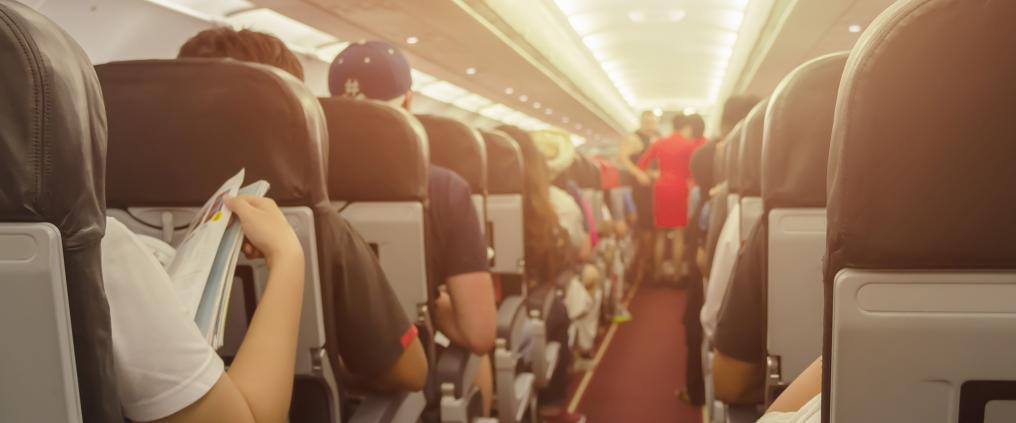“The difficulty in dealing with misbehaving passengers in-flight is that there’s no way to remove the customer from the premises. You have to come up with another way to diffuse the situation,” says Riina Keinonen, known for her blog “Sarkasmia ja shampanjaa” (Sarcasm and champagne).
Currently, Keinonen is on maternity leave but prior to that she worked as a flight attendant on charter flights for two years.
Keinonen says that typically difficult situations on vacation flights involve a passenger who has had too much to drink.
“In my experience, 90% of difficult situations on board are related to alcohol consumption,” she says.
“I understand that people want to let loose and have fun on their holiday. But noisy behavior can disturb other passengers. Sometimes intoxicated passengers also get angry when we refuse to serve them drinks – especially in business class, if they have paid extra for the services,” Keinonen clarifies.
“But they also need to understand that in an emergency, passengers must be in the proper condition to vacate the plane quickly. Stressing this safety argument often pays off.”
Safety first
Tension between cabin crew and passengers often arises from the strict safety directives on board. Though passengers may find them restrictive, crew members must ensure that safety rules are abided by.
“For instance, we cannot let kids run, play or sleep in the aisles, as turbulence can hit at any time even when the skies are clear. These children could be in danger if they do not stay in their seats,” Keinonen explains.
“We can’t let children sit in their parents’ laps on a different row either, as there is limited number of oxygen masks per row. In case of emergency, passengers only have about 18 seconds to put the mask on before hypoxia starts to take effect, so there is no time to jump between rows.”
"I hope passengers understand that we do not correct them out of spite, but to keep them safe.”
The same applies for toilets: In most planes, there are only two masks per toilet, which is why parents are not allowed to go change their baby’s diaper together. Keinonen says children usually listen to and obey flight attendants, but parents can be somewhat tougher to manage.
“In the end they usually understand if you explain things in a calm manner. I hope passengers understand that we do not correct them out of spite, but to keep them safe.”
Stopover and handcuffs as last resources
As part of flight attendant training, cabin crew members are trained to deal with difficult customer situations. The basic principle is to diffuse the situation with as little disturbance to other passengers as possible.
Here are Keinonen’s five tips for handling difficult customers on board:
1) Put yourself in the customers’ shoes
“It is important to understand the customer’s behavior and where the annoyance stems from. They may be tired and hungry, or dismayed that their long-awaited vacation isn’t going according to plan. Most situations can be settled with a genuine apology and some small compensation like a complimentary chocolate bar or extra drink free of charge.”
2) Be strict and don’t lose your authority
“Although we are always flexible and address passengers in a polite manner, cabin crew should not be submissive. We should not lose our authority, but must stick to the rules. Belittling or inappropriate touching should not be tolerated by the crew.”
3) Don’t embarrass or provoke a passenger
“Crew members need to be careful not to embarrass the passenger in front of other customers, or provoke them by using incorrect language. I try to crouch down to be able to address the passenger face-to-face or I ask them to step aside for a talk. Our aim is to calm the situation down and avoid triggering aggressive behavior.”
4) Make sure the whole aircrew behaves consistently
“It is also important that each crew member is made aware of the difficult situation for everyone to be able to behave accordingly. If one of the flight attendants has refused to serve a passenger a drink, the others shouldn’t do that either. While the air crew always has each other’s backs in difficult situations, often other passengers have also been helpful, although we are trained to deal with them without external help.”
5) As last resorts, stopover or cuffing the passenger are options
“If the situation is extreme, cabin crew can threaten the passenger with a stopover. The passenger would have to get off the plane and compensate the costs of the stopover, which can be tens of thousands of euros. I’ve never actually had to witness a stopover, but I have used it to threaten misbehaving passengers multiple times. Usually it works rather well.
As the last resource, aggressive passengers, in danger of hurting themselves or others can be handcuffed by the cabin crew. Thankfully I’ve never had to go that far, but I know that even some of my petite female colleagues have had to cuff an aggressive male passenger.”
Tips from a flight attendant: It's fun to travel with kids
Tips from a flight attendant: Staying healthy during the flight and after arrival
Check out Keinonen’s blog (in Finnish) here.



